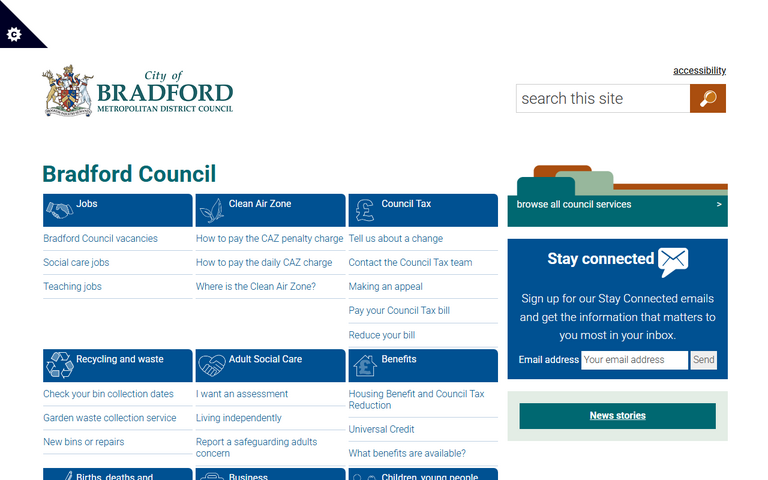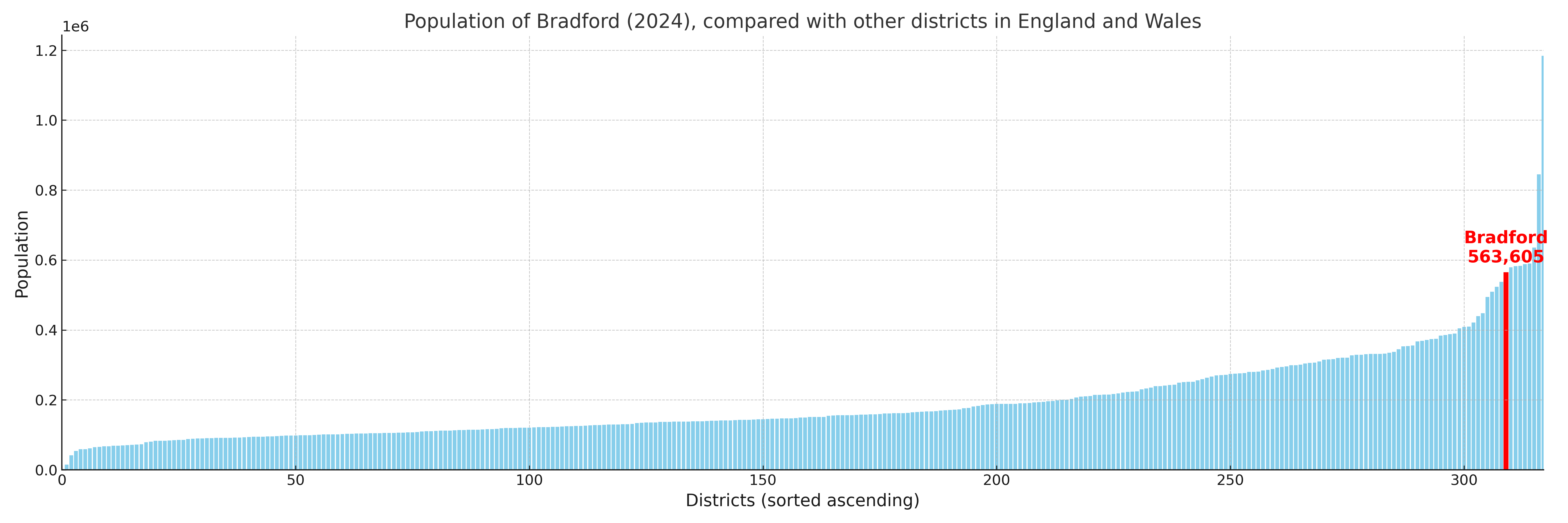Bradford
§ This page gives an overview of the Bradford local authority district, bringing together key facts, maps, and data to help you quickly understand the area. One of 361 district profiles on Baseview.
Overview ⁞ Bradford lies at the foothills of the Pennines in West Yorkshire, a city surrounded by valleys, moorland, and historic towns. The city centre is notable for its grand Victorian architecture, including City Hall, and cultural landmarks such as the Alhambra Theatre and National Science and Media Museum. The UNESCO World Heritage Site of Saltaire, a model village with historic mills and galleries, reflects Bradford’s textile heritage. The surrounding countryside includes Ilkley Moor and Brontë Country, with Haworth village linked to the Brontë sisters. Suburban towns such as Shipley, Keighley, and Bingley sit among green valleys, canals, and reservoirs, offering a mix of urban and rural scenery.
Bradford Boundary Map
This map shows the official boundary of the Bradford local authority district, based on the latest geographic data published by the Office for National Statistics (ONS). It provides a clear view of the district’s extent and helps you understand how the area fits within the wider regional and national landscape.
Contains OS data © Crown copyright and database right 2025. Source: Office for National Statistics licensed under the Open Government Licence v3.0.
The administrative boundary of Bradford can also be viewed on OpenStreetMap: District Boundary of Bradford.
Key Facts about Bradford
What region is Bradford in? Bradford is in the Yorkshire and The Humber of England, a region within the UK.
What county is Bradford in? Bradford is located in the county of West Yorkshire.
Is Bradford a city? Yes, Bradford is a city. Bradford holds official city status as one of the 76 designated cities in the UK.
Who governs Bradford? The local government for this district is: Bradford City Council (Metropolitan District).
▶ Official website of Bradford City Council 🔗 bradford.gov.uk

Which police force covers Bradford? Policing in Bradford is provided by West Yorkshire Police 🔗 westyorkshire.police.uk, which serves 5 local authority districts: Bradford ⁞ Calderdale ⁞ Kirklees ⁞ Leeds ⁞ Wakefield.
Bradford in International Geographies
In the International Territorial Levels (ITLs) hierarchy, Bradford is an ITLs Level 3 area:
- (ITL 1) Yorkshire and The Humber
- (ITL 2) ⇒ West Yorkshire
- (ITL 3) ⇒⇒ Bradford
The International Territorial Levels are used by OECD member countries for statistical purposes to classify administrative areas. We have this listable page for easy browsing of ITL names and codes: International Territorial Levels.
Constituencies in Bradford
Bradford is divided into 5 parliamentary constituencies, listed below in alphabetical order.
A constituency is a specific geographical area that elects one Member of Parliament (MP) to represent them in the House of Commons. The United Kingdom is divided into 650 parliamentary constituencies, 54 of them are in Yorkshire and the Humber region. We have this list page for easy browsing of all UK parliamentary constituencies: List of Constituencies.
Wards in Bradford
Bradford is divided into 30 wards, listed below in alphabetical order.
- Baildon
- Bingley
- Bingley Rural
- Bolton and Undercliffe
- Bowling and Barkerend
- Bradford Moor
- City
- Clayton and Fairweather Green
- Craven
- Eccleshill
- Great Horton
- Heaton
- Idle and Thackley
- Ilkley
- Keighley Central
- Keighley East
- Keighley West
- Little Horton
- Manningham
- Queensbury
- Royds
- Shipley
- Thornton and Allerton
- Toller
- Tong
- Wharfedale
- Wibsey
- Windhill and Wrose
- Worth Valley
- Wyke
In the UK, a ward is a subdivision of a local authority area, used mainly for electoral and statistical purposes. Defined by the ONS, wards represent the primary unit for local elections, each returning one or more councillors to the local council. Wards are also used as a key geography for presenting population and census data.
Parishes in Bradford
Bradford is part-parished: 21 civil parishes (listed A-Z below) alongside 10 unparished areas.
- Addingham
- Baildon
- Bingley
- Burley
- Clayton
- Cross Roads
- Cullingworth
- Denholme
- Harden
- Haworth and Stanbury
- Ilkley
- Keighley
- Menston
- Oxenhope
- Sandy Lane
- Shipley
- Silsden
- Steeton with Eastburn
- Trident
- Wilsden
- Wrose
A civil parish is the lowest tier of local government in England, used for villages, small towns, and suburbs. They have their own local authority, either a parish council or a parish meeting, which provides local services like managing parks, allotments, and streetlights, and represents the community's views to larger councils.
Built-up Areas in Bradford
Bradford covers 32 built-up areas, listed below in alphabetical order.
- Addingham *
- Baildon
- Bingley
- Bradford *
- Brighouse *
- Burley in Wharfedale *
- Cross Hills *
- Cullingworth
- Denholme
- East Morton
- Esholt
- Gomersal and Birkenshaw *
- Guiseley *
- Halifax *
- Harden
- Haworth
- Ilkley *
- Keighley
- Menston *
- Oakenshaw *
- Oakworth
- Oxenhope
- Pudsey *
- Queensbury
- Rawdon *
- Shelf and Northowram *
- Shipley (Bradford)
- Silsden
- Steeton *
- Thornton (Bradford)
- Wilsden
- Yeadon *
In the UK, a Built-up Area (BUA) is a continuous urban area of at least 20 hectares (0.2 km²), defined by the ONS as land where buildings are generally no more than 200 metres apart, such as towns, cities, or large villages. (Note: A BUA name marked with an asterisk (*) indicates that the area is situated partly in the district of Bradford.)
Bradford compared with other districts in the UK
This section shows how Bradford compares with other local authority districts in the UK, using a variety of measures and rankings.
Bradford has 30 electoral wards.

Bradford has a population of 563,605 (2024 mid-year estimate by ONS)

More local statistics and data for Bradford can be found on the ONS statistics for Bradford.